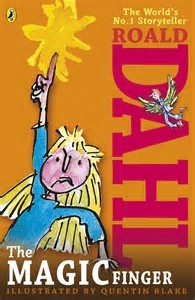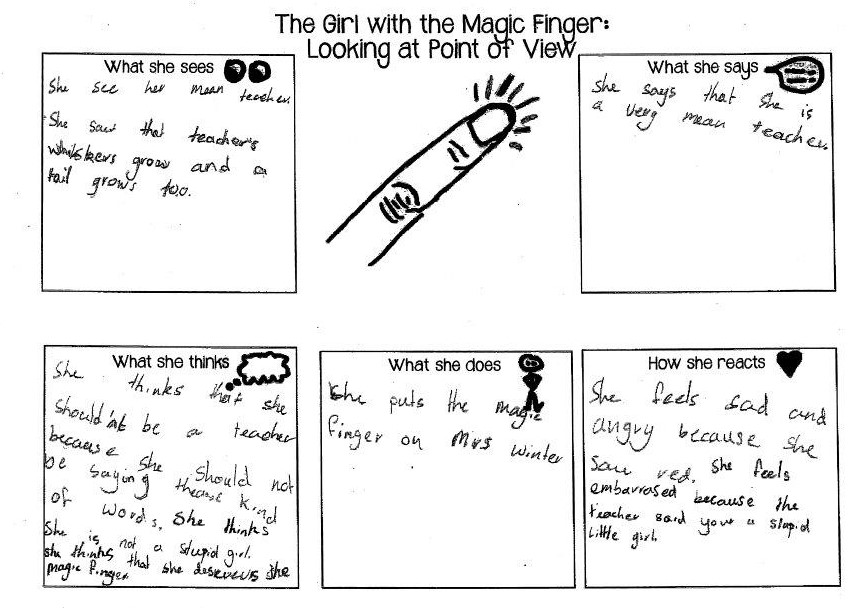In this lesson
we are learning to understand how authors use point of view to reveal what the characters think, see, say and do.
Text
 The Magic Finger, Author Roald Dahl Jonathan Cape Ltd & Penguin Books Ltd.
The Magic Finger, Author Roald Dahl Jonathan Cape Ltd & Penguin Books Ltd.
Links to the Victorian Curriculum - English
- Victorian Curriculum (English) Reading and Viewing: Literacy
- Level Three: Identify the point of view in a text and suggest alternative points of view (Content description VCELY255)
- Victorian Curriculum (English) Speaking and Listening: Literature
- Level Three: Discuss texts in which characters, events and settings are portrayed in different ways, and speculate on the authors' reasons (Content description VCELT274)
Links to Victorian Curriculum - English as an Additional Language (EAL)
Pathway B
Reading and viewing
Level B2
- Express personal point of view about a character's actions
(VCEALA359)
- Engage with a diverse range of texts that reflect a variety of cultural beliefs, practices and views
(VCEALA358)
- Make and substantiate inferences and predictions when reading or listening to a text read aloud
(VCEALC350)
Level B3
- Discuss a text by relating ideas in the text to personal experiences or previous learning
(VCEALA438)
- Read for information or recreation in or out of the classroom
(VCEALA434)
- Discuss texts with some understanding of meaning beyond the literal level, moving towards the inferential level
(VCEALC429)
Success criteria
I can find evidence of two examples in the text which tell me what a character sees, thinks, says or does.
Lesson sequence
Explain that in narrative texts, authors help us to understand events, to see what is going on through the point of view of a character to reveal what the character thinks, sees, feels, says and does. As the students read the extract, tell them that they are going to focus on the character of the girl with the magic finger to understand:
- What she sees and hears
- What she thinks
- What she says
- What she does
- How she reacts to what is happening
Model an example for the students. Ask the students to look for examples of these as they read the text. When the group comes back together, they will report back on what they have found and will be expected to read the part in the narrative which supports this.
Students read the text. Teacher listens to each group member read individually, guiding each student to complete the focus.
Students report back to the group providing evidence from the text.
After reading task. Write examples in your book or complete from the points below.
The girl with the Magic Finger-Looking at Point of View
What to look for:
- What she sees
- What she says
- What she thinks
- What she does
- How she reacts
What is the evidence from the text for each of these points?

Lesson 2
Learning intention
We are learning to understand the use of first person in a narrative.
Success criteria
I can find evidence of first person pronouns in the text.
Explicit teaching - First person point of view
- Explain to the students: In the Magic Finger, Roald Dahl tells us the story from the point of view of the girl with the magic finger. He uses first person or pronouns like 'I' and 'we' to let us know that the girl with the magic finger is telling the story. Let's read a part of The Magic Finger which is told from the girl's point of view:
For months I had been telling myself that I would never put the Magic Finger upon anyone again- not after what happened to my teacher, old Mrs Winter.
Poor old Mrs Winter.
One day we were in class, and she was teaching us spelling. 'Stand up,' she said to me, 'and spell cat.'
'That's an easy one,' I said. 'K-a t.'
'You are a stupid little girl!' Mrs Winter said.
'I am not a stupid little girl!' I cried. 'I am a very nice little girl!'
(Acknowledgement: Roald Dahl The Magic Finger, Jonathan Cape Ltd & Penguin Books Ltd) - Highlight words which help us understand that the story is told from point of view of the girl with the Magic Finger. Model first by selecting a sentence and thinking aloud (e.g. One day
we were in class and she was teaching
us spelling). The teacher underlines the words that show the girl is telling the story (i.e. 'we' and 'us'. 'She' cannot be underlined because it refers to Mrs Winter). Introduce the metalanguage 'pronoun' and explain its meaning: Pronouns are words we use in place of noun groups so that we do not have to constantly repeat them. The examples in this extract are personal pronouns and they refer to the person speaking, or the 'first' person. Students are then asked to underline other examples that they can find of first person pronouns.
- Group members share what they have underlined. List on an anchor chart. Also discuss pronouns which are not first person and why (i.e. 'She' is the pronoun which refers to the person spoken of or about which in this case is Mrs Winter. We call this third person. 'You' is the pronoun used to refer to the person spoken to. We call this second person).
- Ask students to use the anchor chart to help them find examples of first person pronouns in the texts they read during independent reading time. Place a sticky note on a page where they can find an example to share with the class.
Extract from The Magic Finger (pages 4 - 7) 257 words
For months I had been telling myself that I would never put the Magic Finger upon anyone again- not after what happened to my teacher, old Mrs Winter.
Poor old Mrs Winter.
One day we were in class, and she was teaching us spelling. 'Stand up,' she said to me, 'and spell cat.'
'That's an easy one,' I said. 'K-a t.'
'You are a stupid little girl!' Mrs Winter said.
'I am not a stupid little girl!' I cried. 'I am a very nice little girl!'
'Go and stand in the corner,' Mrs Winter said.
Then I got cross, and I saw red, and I put the Magic Finger on Mrs Winter good and strong, and almost at once…
Guess what?
Whiskers began to grow out of her face! They were long black whiskers, just like the ones you see on a cat, only much bigger. And how fast they grew! Before we had time to think they were out to her ears!
Of course the while class started screaming with laughter, and then Mrs Winter said, 'Will you be so kind as to tell me what you find so madly funny, all of you?'
And when she turned around to write something on the blackboard we saw that she had grown a tail as well! It was a huge bushy tail!
I cannot begin to tell you what happened after that, but if any of you are wondering whether Mrs Winter is quite all right again now, the answer is No. And she never will be.
(Acknowledgement: The Magic Finger, Author Roald Dahl, Jonathan Cape Ltd & Penguin Books Ltd.)